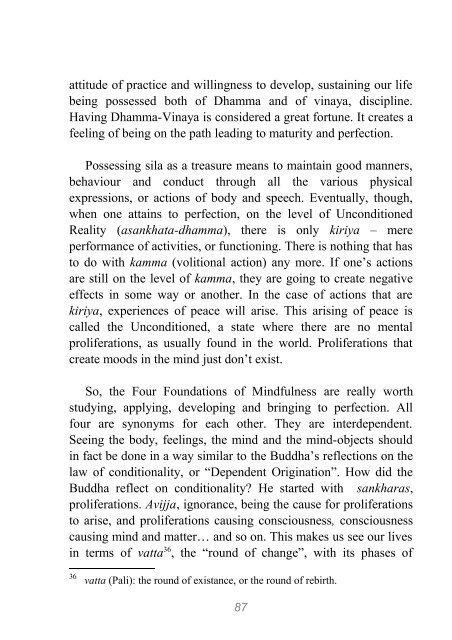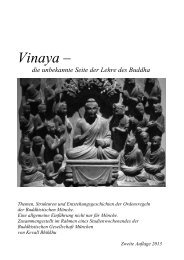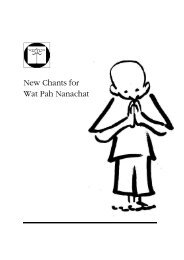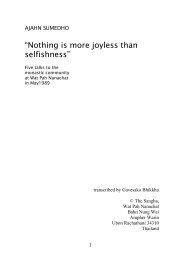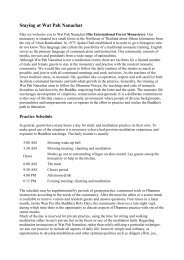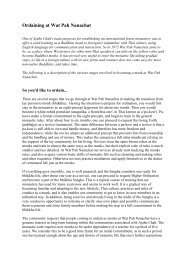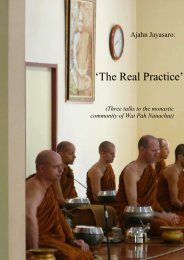Luang Por Liem: The Ways of the Peaceful - Wat Pah Nanachat
Luang Por Liem: The Ways of the Peaceful - Wat Pah Nanachat
Luang Por Liem: The Ways of the Peaceful - Wat Pah Nanachat
You also want an ePaper? Increase the reach of your titles
YUMPU automatically turns print PDFs into web optimized ePapers that Google loves.
attitude <strong>of</strong> practice and willingness to develop, sustaining our life<br />
being possessed both <strong>of</strong> Dhamma and <strong>of</strong> vinaya, discipline.<br />
Having Dhamma-Vinaya is considered a great fortune. It creates a<br />
feeling <strong>of</strong> being on <strong>the</strong> path leading to maturity and perfection.<br />
Possessing sila as a treasure means to maintain good manners,<br />
behaviour and conduct through all <strong>the</strong> various physical<br />
expressions, or actions <strong>of</strong> body and speech. Eventually, though,<br />
when one attains to perfection, on <strong>the</strong> level <strong>of</strong> Unconditioned<br />
Reality (asankhata-dhamma), <strong>the</strong>re is only kiriya – mere<br />
performance <strong>of</strong> activities, or functioning. <strong>The</strong>re is nothing that has<br />
to do with kamma (volitional action) any more. If one’s actions<br />
are still on <strong>the</strong> level <strong>of</strong> kamma, <strong>the</strong>y are going to create negative<br />
effects in some way or ano<strong>the</strong>r. In <strong>the</strong> case <strong>of</strong> actions that are<br />
kiriya, experiences <strong>of</strong> peace will arise. This arising <strong>of</strong> peace is<br />
called <strong>the</strong> Unconditioned, a state where <strong>the</strong>re are no mental<br />
proliferations, as usually found in <strong>the</strong> world. Proliferations that<br />
create moods in <strong>the</strong> mind just don’t exist.<br />
So, <strong>the</strong> Four Foundations <strong>of</strong> Mindfulness are really worth<br />
studying, applying, developing and bringing to perfection. All<br />
four are synonyms for each o<strong>the</strong>r. <strong>The</strong>y are interdependent.<br />
Seeing <strong>the</strong> body, feelings, <strong>the</strong> mind and <strong>the</strong> mind-objects should<br />
in fact be done in a way similar to <strong>the</strong> Buddha’s reflections on <strong>the</strong><br />
law <strong>of</strong> conditionality, or “Dependent Origination”. How did <strong>the</strong><br />
Buddha reflect on conditionality? He started with sankharas,<br />
proliferations. Avijja, ignorance, being <strong>the</strong> cause for proliferations<br />
to arise, and proliferations causing consciousness, consciousness<br />
causing mind and matter… and so on. This makes us see our lives<br />
in terms <strong>of</strong> vatta 36 , <strong>the</strong> “round <strong>of</strong> change”, with its phases <strong>of</strong><br />
36 vatta (Pali): <strong>the</strong> round <strong>of</strong> existance, or <strong>the</strong> round <strong>of</strong> rebirth.<br />
87


